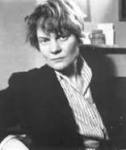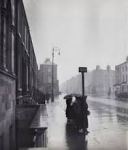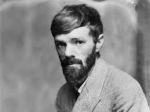The Red and the Green was Iris Murdoch’s seventh novel and stood out in her fictional career as a unique attempt to capture an historical event. The topic was The Easter Rising, Dublin 1916, in which independence fighters staged an abortive attempt to defeat the island’s British rulers. Home Rule was anyway in the offing, and six years later a free Ireland was born.
Murdoch was interested in two things: an era of heroism and accounting for her own departure from Ireland and Irishness. Born into an Anglo-Irish family in Dublin in 1919 she, like Frances in the novel, left to make her adult life in England and never returned. But in a coda to the novel’s main action she had Frances more than two decades on weep at the memory of good men; and especially at the memory of rebel leader Pat Dumay, whom she had secretly loved. When she wrote the novel in 1965, as if for the half-centenary of the Easter Rising the following year, Murdoch wished, through Frances, that the feelings surrounding the Dublin men’s self-sacrifice for their country shouldn’t be forgotten. Again through Frances she compared it to the moral debacle of the Spanish Civil War. National feeling was also a mystical element in the novel.
Murdoch in England felt with her characters on both sides of the divide and all around it. The mystique of old times and of the fighting spirit of oppressed small nations was something Frances’s English husband, decent, kind, an Establishment figure, could not appreciate. Frances too chose England, yet loved Pat.
None of her novels before or after reflected quite such a battlefield of loyalties, in one city and two closely linked families. Moreover they were loyalties that went to the heart of her growing body of work as a writer and philosopher. She was interested in moral feelings; in the dialogues people had internally with themselves over the right thing to do; in feelings of love avowed and hidden, known and unconscious. Interwoven through the whole was the role religious faith played in those feelings, or not. ‘Muddle,’ was a repeated word. Perhaps it was the case that you couldn’t have heroism without muddle. That in turn left Murdoch, a philosopher, in some professional difficulty. Another repeated, spurned idea in the novel was ‘logic’. Logic never helped anyone work out what to do.
The descriptions of Dublin were rich and evocative, the dialogue sharp, and the characters among the most convincing she ever created. This was Murdoch at her nineteenth-century realist best, with only a hint, at the end, of the kind of Dostoevskian Gothic that would turn too much of her fiction into arch melodrama.
In fact Pat Dumay did not particularly stand out as lovable among the brilliant interweave of English, Irish and Anglo-Irish characters. But he was noble. What was said in the novel of the historical figure of Roger Casement, whom the British later hanged, applied to Pat. ‘He’s a brave man and a patriot. He does it purely for love of Ireland. To love Ireland so much, to love anything so much, even if he’s wrong-headed, is somehow noble.’ Pat Dumay felt ‘the enormity of the insult laid upon his people.’ More intimately, he was a Lawrentian figure in his physicality, only with an un-Lawrence-like obsession with sexual purity. He loves none of the women in the book. One passing suggestion is he might prefer men. The scene when his fourteen-year-old brother Cathal prepares him a hot bath sticks in the memory as uniquely sensual. Their father long dead, Pat will guard Cathal with his life, in a relationship that is at once surrogate-paternal and erotic.
Cathal, precociously involved and desperate to fight, takes up themes often underplayed in historical accounts of the event. The rebels’ cause was overlaid with a sense that they were overthrowing the ruling class in the name of the international proletariat. One of their leaders, James Connolly, Cathal’s hero, was a follower of Lenin. Murdoch as a young woman had been a Communist sympathiser.
Like any novelist she couldn’t help setting out, early on, many of the themes that would recurr through her work. To moral muddle add sexual muddle and gender confusion, and remnants of mystical and religious feeling her characters don’t know what to do with. It is rightly said that though this novel was set in 1916 it was suffused with the sexual liberation of the early 1960s and with the questioning of traditional gender roles.
The author has a particular debate with herself in The Red and the Green over what kind of woman to be. Frances is bright and determined but remains demure. She embarks on a conventional marriage, with children, which turns out happy if slightly dull. Her opposite is Millie, a flamboyant aristocrat said to have been inspired by the historical figure of Constance Markievicz. Millie wears trousers and instals a shooting gallery in her home. Her animality – Murdoch uses the word – her prettiness and her charm repeatedly ravish men. To use another 1960s word, when such behaviour was still seen as unconventional and unacceptable, Millie was promiscuous in her favours and probably never really in love, except with the heroic, unreachable Pat Dumay. There are moments when Millie seems like a principal boy in an operetta, or a schoolgirl playing a man on stage. She’s pushing the boundaries of gender.
Another 1960s element was a strong whiff of existentialism: of defining oneself through action rather than, as long centuries of philosophy had insisted, through contemplation. Murdoch had written one of her most successful books on Jean-Paul Sartre’s ethos of political commitment.
Looking from outside, Murdoch herself was at least two things. She was an English conservative Romantic, picking up postwar where the interwar Romantic modernists had led in painting and poetry. She loved landscape, light, sea, and was inclined to find there some metaphysical significance. She was also a liberated woman of androgynous appearance and inclination, leading a bisexual life that would force her to resign her Fellowship at St Annes College, Oxford. Her fiction fused mystical love with the discovery of the decade that casual sex could be fun.
In The Red and the Green a terrific, conflicted character called Barney has had to abandon his vocation as a priest because of his feelings for the ‘animal’ Millie. Ever after, even after having married the staid Kathleen and become an alcoholic figure of fun and pity, he hangs around Millie’s Dublin home. In fact this failed priest draws from Murdoch an extended outpouring of religious feeling, as he follows the progress of the Easter story. These feelings in turn segue into a mystical sense of ‘Ireland’. The English in Ireland don’t get it. ‘In Ireland religion was a matter of choosing between one appalling vulgarity and another,’ says Andrew Chase-White, who always hoped to marry Frances. But Barney, even as he denounces the rebels as incapable of running the country, and the Irish church as ‘mushy devotional nonsense’, always comes back to some national essence. ‘Ireland for him was a dark place, slow dignified and mystical.’
In Murdoch’s wonderful evocations, the weather has a great deal to do with Ireland’s distinctiveness. The rain in Ireland, she once said, had the same mystical import as snow in Russia.
History was the feeling of ‘a rhythm of a much larger scheme which has included us within its composition.’ (Chapter 12) Although here she sounded pedestrian, what attracted her, as a writer, was the moment of historical witness. ‘Of course the men had been told, from long ago, that they must be prepared for anything on any occasion when they marched out at arms. But they had marched out in arms so often and returned afterwards to their tea. There was a ferment in Dublin all the same …[which] was dangerous. It was still only Thursday.’ She didn’t quite capture that ferment, but she made the Easter Rising a stunning family affair in a haunting city.






